The expected revenue of veneer, plywood, and engineered wood product manufacturing will rise to 300 billion U. S. Dollars by 2024, as per the research of Statista Research Development.
This research is quite enough to state the increasing popularity of engineered wood over time.
Now, you may ask what engineered wood is.
If you are already aware of it, you are here to get vivid clarity about engineered wood types, advantages, and disadvantages.
So, Let’s delve into the absolute details of engineered wood.
What is Engineered Wood?
In easy words, engineered wood is the replacement for solid wood since it is prepared artificially. Trees and natural wood are limited with the increment of a massive population. So, solid hardwood is restricted in quantity.
Engineered wood is prepared by pasting different layers containing sawdust, wood leftover, and fibers with adhesive or gluing by passing through pressure and temperature processes. These processes provide fruitful results with sturdy and stable engineered wood. It has the cladding of solid wood and contains different layers of wood named ply.
You will be surprised to know about the gigantic uses of engineered wood, such as in the construction of homes, paneling, flooring, false ceilings, office buildings, and industrial goods.
Characteristics of Engineered Wood
Inspect carefully between high-quality and low-quality engineered hardwood. Read ahead the critical characteristics of engineered hardwood that you need to know:
1. What makes engineered wood strong?
The core of the engineered wood makes it a hard and rigid wood and is best suitable for flooring purposes.
The reason for core strength is plywood is infused in this part to increase its durability and strength.
2. The Upper Veneer:
The upper veneer is also known as the wear layer. You can touch the surface to recognize whether it is engineered wood or not. The wear layer of engineered wood is about 4 mm.
Apart from the top layer, other beneath layers have different components of various wood. Varying elements of engineered wood are responsible for changing the features with different types, being strong, medium, or weak.
3. Customized dimensions & large size:
Engineered hardwood satisfies your needs since it comes with a long length and wide width. It reduces the number of pieces to be used in construction work. Another characteristic is its customized dimensions.
4. Ease your work in construction:
The lightweight wood feature of engineered wood expedites your work with the ease of handling and transforming it. That is time and energy-saving too. Easy to cut and join the pieces of engineered wood. All at once, it accelerates your construction work.
Benefits of Engineered Wood
You need not bother about getting your flooring done through expensive solid hardwood.
Since engineered wood has a top layer of hardwood, it is affordable too.
It has a plethora of benefits as solid hardwood has. Check out the curated list of advantages of Engineered wood.
1. Pocket-Friendly:
Hardwood is an expensive choice. But you have an affordable alternative, and that is engineered wood. It is affordable and artificial wood with usable perks.
2. Remarkable Appearance:
Engineered wood is lavishly modish. It has a pleasing look because of the processes it goes through to become the final product.
3. Repels Moisture, Temperature, and Electricity:
As you know various particles are compressed, heated, and pressured. That adds to the strength of engineered wood. So, no fear of extension or shrinkage apart from exceptional cases.
4. Hygienic:
The better choice is engineered wood to fulfill your requirements for tidy and hygienic floors. This wood does not grab any dust particles, debris, or detritus. It is handy and quick to clean to ensure you have bacteria-free flooring.
5. Feasible & Sustainable:
It is crystal clear that engineered wood has comparatively less wood than solid hardwood. You will be ecstatic to know that engineered hardwood is a good conductor of heat owing to its dense core. It will naturally maintain warmth in your house. Your efforts will be reduced to an extent to keep the mild temperature in your house.
6. Better Utilization of Waste:
Sawdust, leftover wood, swap mills, etc. are included in the engineered wood formation. That is how waste is recycled and used optimally.
7. Strong & Sturdy wood:
Engineered wood is highly dense, and the credit goes to its different firm layers.
8. Competently Versatile Wood:
Use engineered wood for a variety of purposes, such as wood flooring, cutting as a veneer, or overlaying it with other wood. Choose any of the systems you need, such as tongue, groove, or click system.
Disadvantages of Engineered Wood
Some of the flaws of engineered wood that you must be aware of are as follows:
1. Less Strength:
The potential of an engineered wood entirely depends on the stuff filled in it. Elements being low in quality in the different layers of engineered wood concludes it is poor-quality wood. The solution is you can make a deal with a reliable and top-caliber manufacturer.
Additionally, be careful to know if engineered hardwood contains oriented strand board (OBS). It impacts harshly the durability of wood.
2. Time for Maintenance:
Regular cleaning and maintenance are required to retain the bright and smooth surface of engineered wood. It is a point to be noted, specifically for those having pets or kids.
3. The Problem of Fading:
Engineered wood is susceptible to damage and fading away. UV rays affect the appearance and color of engineered wood badly.
Having said that, UV rays harm each thing they come in contact with. You can use carpets and curtains or shield them with other methods to protect them.
4. Not Ideal to Refinish:
You can not refinish the engineered wood as you can paint over and again in the case of solid hardwood. So, engineered wood is not suitable to sand over.
5. Less Durable than Solid Hardwood:
Though engineered hardwood is dense and strong, its durability is limited to only a maximum of 40 years. On the contrary, solid hardwood is a long-running wood to be usable for a century.
6. Visible Wood Strips:
Wood strips are noticeable on the engineered wood surface as compared to the tidy and plain surface of solid wood. That affects the appearance of engineered wood.
7. Prone to moisture and dents:
Engineered hardwood has great resistance power against moisture, yet it is prone to shrinkage and dents by contact with water. In addition, dents and scratches are unremovable in this wood. Laminating flooring and solid hardwood impress better in the case of dealing with the problem of gauges and bents.
8. High-quality engineered wood comes with a high cost:
No doubt, engineered hardwood is cheaper than solid hardwood. If you want wood flooring for the long term, you will have to invest in top-notch and expensive engineered wood. Some engineered wood incurs high costs, such as LSL and plywood.
Uses of Engineered Wood
Engineered Wood uses are infinite. It is a perfect alternative to solid hardwood.
Uses of engineered wood vary as some types of engineered wood can be used for large construction work where others can not.
Go over the list of uses of engineered wood:
- For furniture purposes.
- Interior work of the office.
- For home and building construction.
- Boat construction.
- For bookshelves, beds, and benches.
- For kitchen furniture like countertops.
- Used in different elements of your house, from roofs to columns and shear walls.
- Used in various building components such as floors, roofs, and walls.
Various Types of Engineered Wood
You are definitely planning for flooring or other wood-related construction. That’s why you are here. Searching and examining things before investing a penny is a wise step you have taken.
The adaptability and compliance of engineered wood make it a favorite wood of interior designers and constructors. Engineered wood is cost-effective too.
Why do you need to take time and consider different types of engineered wood to purchase one of them?
They are dissimilar in all aspects from features, potential, and prices to their motives and situations to use. Bear the following engineered wood types in mind while installing them in your space.
1. Plywood
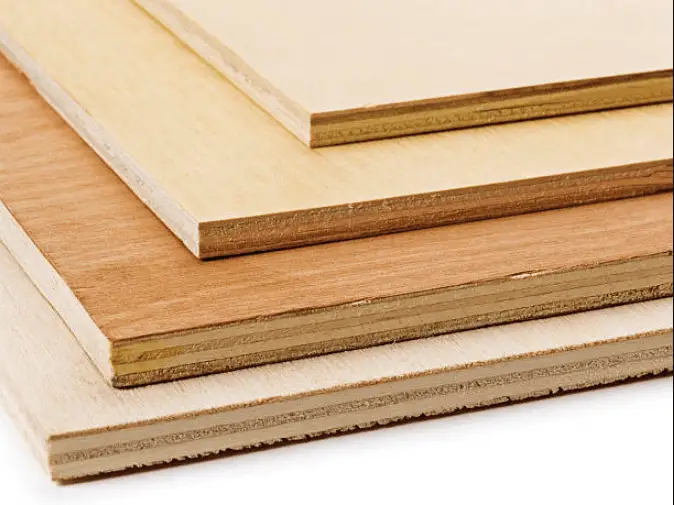
Plywood is placed at the top of the list because it is senior among the rest of the engineered woods. It is the oldest and most well-tested engineered wood made by attaching firmly different plies or veneer sheets by gluing, pressurizing, and heating.
Due to this, engineered wood has a cross-graining feature that provides stability and boosts its potential.
It is known for its robustness and durability. Plywood comes on the top while lagging behind other engineered woods regarding its resistance against wood strapping and robustness.
It has a strong grip on screws and nails because of its cross-grain pattern. It varies in thickness, and grades are given. So you have options to choose particular plywood.
Importantly, you can use plywood for moisture-prone areas like the kitchen and bathroom.
Plenty of plywood applications are for construction purposes, internal paneling, structural furniture, and commercial spaces.
However, it comes with some limitations, such as:
- Comparatively more expensive than other engineered woods.
- Sometimes possibilities of expansion and contraction of plywood due to moisture.
- Not appropriate for long-form furniture because it is liable to sink and twist.
2. Higher Density Fiberwood

Higher Density Fiberwood is another well-known engineered wood in the market. During its manufacturing process, oil is added to prepare the polymer.
How is it created?
Oil, wood chips, and waste pulp are compressed firmly using adhesives at a high temperature. HDF comes with a polished structure. It is the most suitable engineered wood for construction tasks like interior flooring. Why? Due to its traits of long-lasting and high density.
It repels moisture and temperature. So, no prospect of expansion or shrinkage of the wood. HDF is more durable as compared with plywood.
Yes, it has limitations, too. The first one is that it is not recommended for outdoor floors. Secondly, lacking the wood grain.
3. Medium Density Fiberwood (MDF)
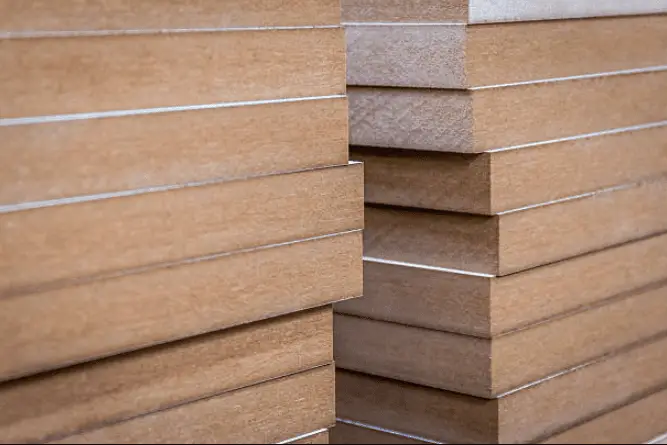
Go ahead knowing the steps of manufacturing Medium Density Fiberwood:
1st step: Pieces of hardwood and softwood are converted into fibers.
2nd step: Mixing of fibers in wax and resin binders.
3rd step: Pressurization and heating of the material to create rigid sheets.
A budget-friendly wood comes with a smooth surface, density, and hardness features. It has a comparatively larger density than plywood. Weather and water-resistant engineered wood is made from recycled wood. It withstands humidity and temperature variations.
Due to its smooth surface, it is easier for you to work with it, like cutting and drilling. A green flag to use it because of its fantastic customization.
For what purposes can you use it?
For decorative covering, deviations, etc.
4. Blockboard
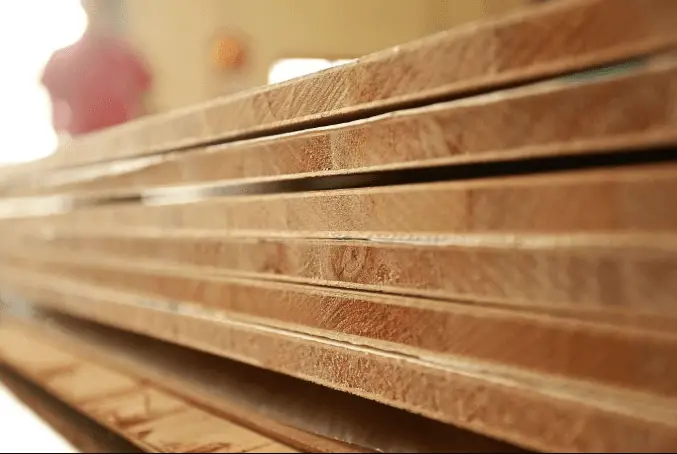
Multiple wood chips and softwood strips are compressed using glue to form a strong and stable engineered wood: blockboard.
In the formation process of the blockboard, narrow and pencil-thin chips are used in the surface layer.
It is a lightweight, movable, and handy wood that makes it effortless to work with. You can use Blockboard to make doors, create storage spaces, and panels, and prepare any kind of table. Use it to create intricate shapes and curves.
What is more!
The cost-conscious wood withstands bending, buckling, and sinking.
It comes with the limitation of being less stronger than other engineered wood. Its main component – softwood strips are responsible for its lower potential.
5. Particle Board
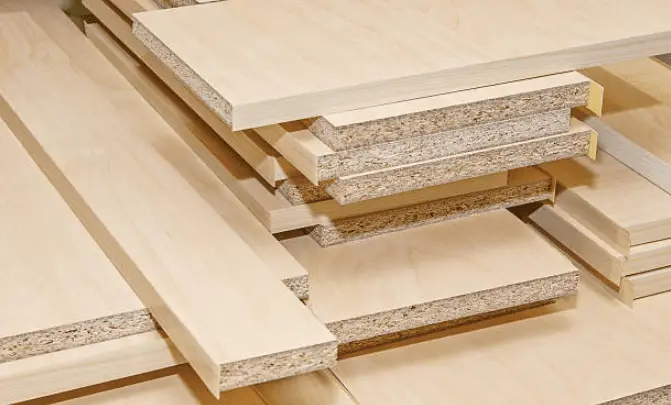
Particle board is formed by pasting together tiny chips, sawdust, wood shavings, scraps, and dust particles by compressing them together. You can take a step toward a sustainable lifestyle by using particle board, as it is an environment-friendly wood.
What is more exciting for nature lovers?
All the material used in the manufacturing of the wood is recycled that used to be thrown away in earlier days. This engineered wood is easily available in the market with a large supply.
Lightweight engineered wood, which means comfort while handling and working with it. Its uniformity and beauty will impress you the most.
You will find it too easy to finish the smooth surface of particle wood.
The pocket-friendly wood comes with the feature of thermo-acoustic insulation.
However, its limitations can demotivate you to not buy it. For instance: It is liable to get enlarged due to the poor quality of its key elements.
The weakest wood can not be used for heavy and large projects. It is unfavorable to moisture that fades away and swells in wet areas.
You can use particle wood for building up furniture and flooring, and the best suitable for wooden walls.
6. Cross-Laminated Timber
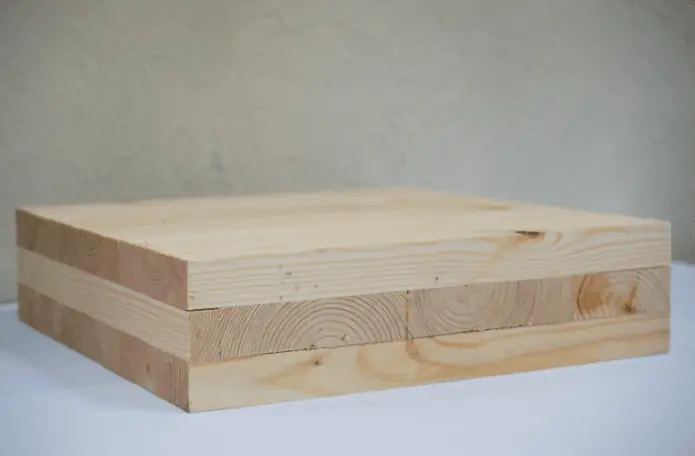
It is made by joining the thin sheets slashed from timber planks by attaching them in perpendicular layers. These sheets are placed equally around the central layer with adjoining layers that have the grain direction at 90 degrees to each other.
It is a strong wood with a thickness of 6mm to 45mm. The thickness of the cross-limited limber is the reason for being used in soundproofing.
The first choice for off-site construction is because it is a strong and sizable timber.
Moisture-absorbent wood with features of withstanding fire, and it does not get gauge or bend.
Being unique, it is a costly engineered wood. Moreover, it is arduous to use pipes and wires through it.
7. Laminated Strand Lumber (LSL)
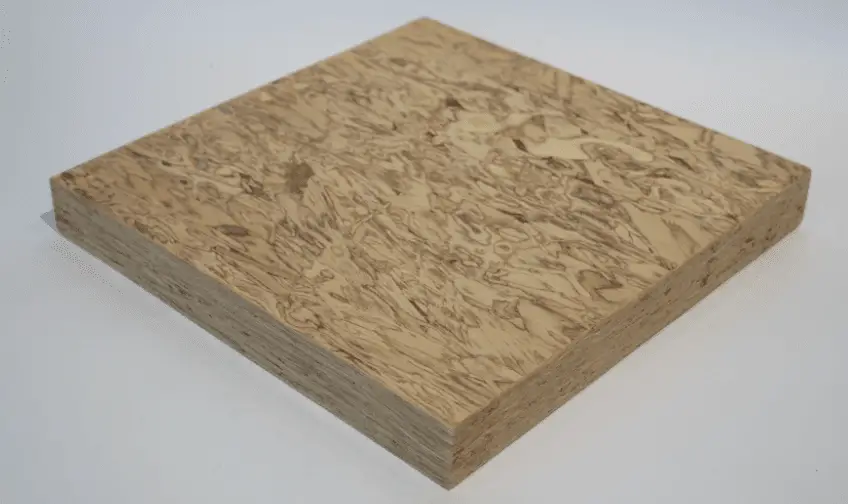
Dehydrated and graded wood veneers and flakes are placed and covered over one another using glue to form Laminated Strand Lumber. These components are pasted in a highly dense and heavy pattern.
You will love its look as it is made from copious tiny wood strips. The composition of LSL is 95% of wood fiber and 5% resin. Top-graded wood is so expensive too. It strongly withstands bends, crookedness, and burden.
8. Laminated Veneer Lumber

As the name suggests, LVL is made of wood veneers. Different veneers are flattened using gums and resins, binding them using heat and pressure.
Lean vertical softwood veneers are placed in a way that their grains are along the side of the longitudinal axis of the part.
Its surface is compounded with great resistance power to warp, bow, and shrink. It is, by and large, used in the framing process owing to its high density,
You can avail the wood for wide spans, for instance: roof and floor joists.
It is restricted to the use of LVL in one direction.
Why?
Wood veneers are stuffed with the grain in the same direction, so it has a solo strength axis.
Frequently Asked Question
Final Words
Wood decors your house to make it the best place for residence. Everything from flooring to cupboards to furniture is made from wood.
You can fulfill your desires using eco-friendly wood like engineered wood.
However, you need to be cautious to examine the pros and cons of different engineered wood to choose a perfect match for your requirements.
